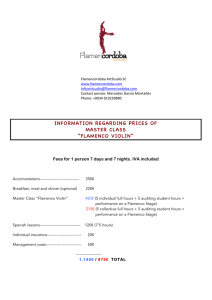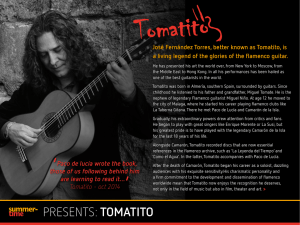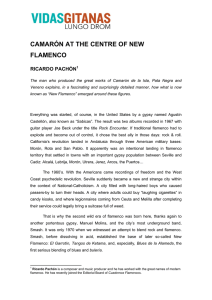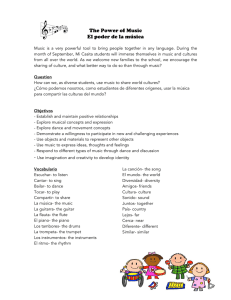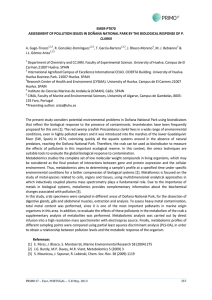Texto completo - Centro de Documentación Musical de Andalucía
Anuncio
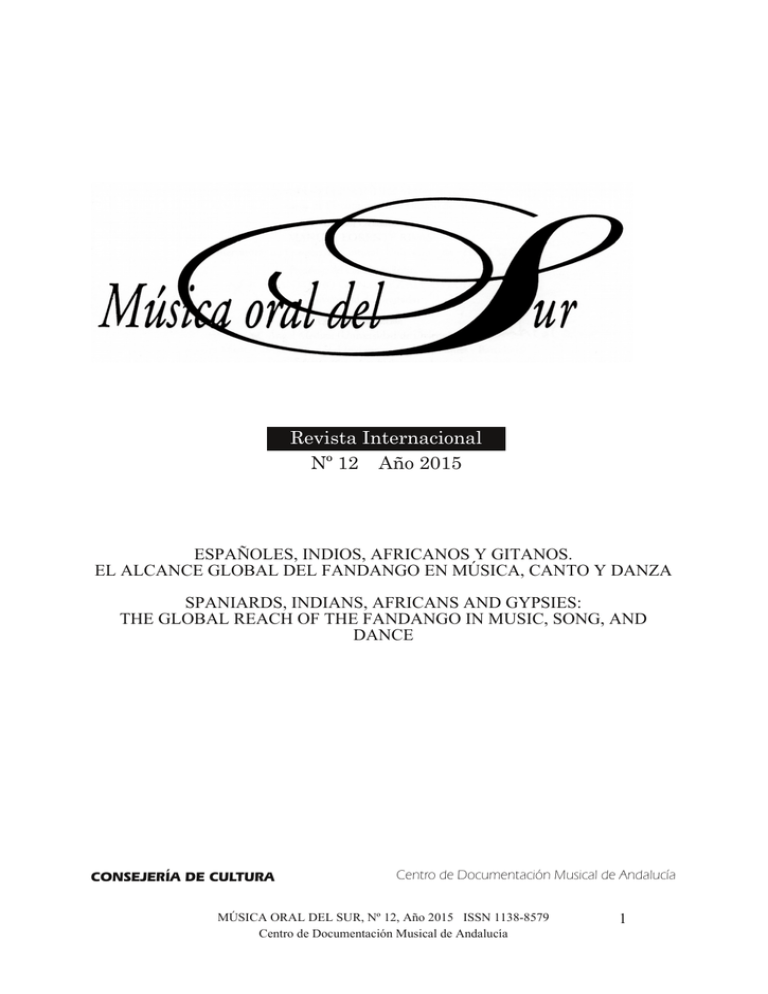
Revista Internacional Nº 12 Año 2015 ESPAÑOLES, INDIOS, AFRICANOS Y GITANOS. EL ALCANCE GLOBAL DEL FANDANGO EN MÚSICA, CANTO Y DANZA SPANIARDS, INDIANS, AFRICANS AND GYPSIES: THE GLOBAL REACH OF THE FANDANGO IN MUSIC, SONG, AND DANCE CONSEJERÍA DE CULTURA Centro de Documentación Musical de Andalucía MÚSICA ORAL DEL SUR, Nº 12, Año 2015 ISSN 1138­8579 Centro de Documentación Musical de Andalucía 1 Actas del congreso internacional organizado por The Foundation for Iberian Music, The Graduate Center, The City University of New York el 17 y 18 de abril del 2015 Proceedings from the international conference organized and held at The Foundation for Iberian Music, The Graduate Center, The City University of New York, on April 17 and 18, 2015 Depósito Legal: GR­487/95 I.S.S.N.: 1138­8579 Edita © JUNTA DE ANDALUCÍA. Consejería de Cultura. Centro de Documentación Musical de Andalucía Carrera del Darro, 29 18010 Granada [email protected] www.centrodedocumentacionmusicaldeandalucia.es Facebook: http://www.facebook.com/DocumentacionMusicalAndalucia Twitter: http://twitter.com/CDMAndalucia 2 MÚSICA ORAL DEL SUR, Nº 12, Año 2015 ISSN 1138­8579 Centro de Documentación Musical de Andalucía Música Oral del Sur es una revista internacional dedicada a la música de transmisión oral, desde el ámbito de la antropología cultural aplicada a la música y tendiendo puentes desde la música de tradición oral a otras manifestaciones artísticas y contemporáneas. Dirigida a musicólogos, investigadores sociales y culturales y en general al público con interés en estos temas. Presidente ROSA AGUILAR RIVERO Director REYNALDO FERNÁNDEZ MANZANO Coordinación K. MEIRA GOLDBERG ANTONI PIZÀ Presidente del Consejo Asesor JOSÉ ANTONIO GONZÁLEZ ALCANTUD Consejo Asesor MARINA ALONSO (Fonoteca del Museo Nacional de Antropología. INAH – Mexico DF) ANTONIO ÁLVAREZ CAÑIBANO (Dir. del C. de Documentación de la Música y la Danza, INAEM) SERGIO BONANZINGA (Universidad de Palermo ­ Italia) EMILIO CASARES RODICIO (Universidad Complutense de Madrid) TERESA CATALÁN (Conservatorio Superior de Música de Madrid) MANUELA CORTÉS GARCÍA (Universidad de Granada) Ma ENCINA CORTIZA RODRÍGUEZ (Universidad de Oviedo) FRANCISCO J. GIMÉNEZ RODRÍGUEZ (Universidad de Granada) ALBERTO GONZÁLEZ TROYANO (Universidad de Sevilla) ELSA GUGGINO (Universidad de Palermo – Italia) SAMIRA KADIRI (Directora de la Casa de la Cultura de Tetuán – Marruecos) CARMELO LISÓN TOLOSANA (Real Academia de Ciencias Morales y Políticas – Madrid) BEGOÑA LOLO (Dirª. del Centro Superior de Investigación y Promoción de la Música, U. A. de Madrid) JOSÉ LÓPEZ CALO (Universidad de Santiago de Compostela) JOAQUÍN LÓPEZ GONZÁLEZ (Director Cátedra Manuel de Falla, Universidad de Granada) MARISA MANCHADO TORRES (Conservatorio Teresa Berganza, Madrid) TOMÁS MARCO (Academia de Bellas Artes de San Fernando – Madrid) JAVIER MARÍN LOPEZ (Universidad de Jaén) JOSEP MARTÍ (Consell Superior d ́Investigacions Científiques – Barcelona) MANUEL MARTÍN MARTÍN (Cátedra de flamencología de Cádiz) MÚSICA ORAL DEL SUR, Nº 12, Año 2015 ISSN 1138­8579 Centro de Documentación Musical de Andalucía 3 ANTONIO MARTÍN MORENO (Universidad de Granada) ÁNGEL MEDINA (Universidad de Oviedo) MOHAMED METALSI (Instituto del Mundo Árabe – París) CORAL MORALES VILLAR (Universidad de Jaén) MOCHOS MORFAKIDIS FILACTOS (Pdte. Centros Estudios Bizantinos Neogriegos y Chipriotas) DIANA PÉREZ CUSTODIO (Conservatorio Superior de Música de Málaga) ANTONI PIZA (Foundation for Iberian Music, CUNY Graduate Center, New York) MANUEL RÍOS RUÍZ (Cátedra de flamencología de Jeréz de la Frontera) ROSA MARÍA RODRÍGUEZ HERNÁNDEZ (Codirectora revista Itamar, Valencia) SUSANA SARDO (University of Aveiro) JOSÉ MARÍA SÁNCHEZ VERDÚ (Robert­Schumann­Musikhochschule, Dusseldorf) FRÉDERIC SAUMADE (Universidad de Provence Aix­Marseille – Francia) RAMÓN SOBRINO (Universidad de Oviedo) Ma JOSÉ DE LA TORRE­MOLINA (Universidad de Málaga) Secretaria del Consejo de Redacción MARTA CURESES DE LA VEGA (Universidad de Oviedo) Secretaría Técnica MARÍA JOSÉ FERNÁNDEZ GONZÁLEZ (Centro de Documentación Musical de Andalucía) IGNACIO JOSÉ LIZARÁN RUS (Centro de Documentación Musical de Andalucía) Maquetación ALEJANDRO PALMA GARCÍA JOSÉ MANUEL PÁEZ RODRÍGUEZ Acceso a los textos completos Web Centro de Documentación Musical de Andalucía http://www.centrodedocumentacionmusicaldeandalucia.es/opencms/documentacion/revistas Repositorio de la Biblioteca Virtual de Andalucía http://www.bibliotecavirtualdeandalucia.es/catalogo 4 MÚSICA ORAL DEL SUR, Nº 12, Año 2015 ISSN 1138­8579 Centro de Documentación Musical de Andalucía FANDANGOS IN VOICES OF WOMEN: ENACTING TRADITION, AFFIRMING IDENTITY Loren Chuse Independent Scholar Resumen: Este artículo presenta un breve resumen del papel clave de la mujer en la creación, la difusión, y la innovación del fandango en el flamenco. Partiendo de los conceptos teóricos de la música como señal importante de la identidad andaluza y regional, y como expresión cultural de la negociación de esta identidad, este ensayo comienza destacando el trabajo la importación de las cantaoras y tocaoras de la época de los cafés cantantes. Continúa presentando un análisis de las contribuciones de cantaoras y mujeres guitarristas contemporáneas, como Carmen Linares, María José Matos, y las cantaoras de la Peña Femenina de Huelva. El trabajo considera además la creatividad de las cantaoras jóvenes, quienes mantienen la tradición del fandango a la misma vez que la innovan. Palabras claves: fandango; flamenco; cantaora; Cafés Cantantes, Huelva Fandangos de Voces de Mujeres: La promulgación de la Tradición, Afirmando Identidad. Abstract: This article presents a brief overview of the key role of women performers in the creation, the diffusion and the innovation of the flamenco fandango. Beginning with theoretical concepts of music as an important expression of both Andalusian and regional identity, and as a site, both physical and conceptual, of the negotiation of these concepts of identity, this essay begins highlighting the contribution of women singers and guitarists of the period of the Cafés Cantantes. It continues with an analysis of the contributions of contemporary women performers such as singer Carmen Linares and guitarist María José Matos, as well as the singers of the Peña Feminina de Huelva. It concludes with the creativity of younger singers, who continue the tradition of the fandango while at the same time innovating new traditions. Keywords: fandango; flamenco; cantaora; Cafés Cantantes, Huelva MÚSICA ORAL DEL SUR, Nº 12, Año 2015 ISSN 1138­8579 Centro de Documentación Musical de Andalucía 517 LOREN CHUSE Biografía Loren Chuse es etnomusicóloga cuyo trabajo se enfoca en estudios sobre el flamenco, principalmente sobre el trabajo y el papel de la mujer en el flamenco, tanto históricamente como en la actualidad. Chuse recibió su Doctorado en la Etnomusicología de la Universidad de California, Los Angeles en 1999. Su tésis doctoral: The Cantaoras: Music, Gender and Identity in Flamenco Song”, publicado por Routledge Press en 2003, fue traducido y publicado más adelante por Ediciones Signatura, con el título: Mujer y flamenco (2007). La Dra. Chuse sigue colaborando en congresos nacionales e internacionales y sigue publicando sus nuevos trabajos sobre el flamenco. Reside en Berkeley, California donde trabaja como profesora. Chuse, Loren."Fandangos in Voices of Women: Enacting Tradition, Affirming Identity". Música Oral del Sur, n. 12, pp. 517­526, 2015, ISSN 1138­8579 INTRODUCTION Music as emblematic of and crucial to a sense of cultural identity is central to recent scholarship in ethnomusicology. Music is acknowledged as an active agent in the affirmation of cultural identity and, consequently, musical practice has been studied as a site, both physical and conceptual, where multiple social identities, of ethnicity, region and gender, are constructed and enacted. Flamenco performance has been key to the creation and maintenance of Andalusian as well as national identity. In truth, flamenco is a continuum of practices: musical, physical, verbal and social, that has served as a site for the negotiation of complex, multi­layered, and often conflicting identities of nation, region and ethnicity. Musical performance often functions as a rich site of memory that is central to processes of self­definition both for the individual and the collective (See Cowan 1990; Loza 1993; Stokes 1994). Flamenco is one such musical practice, for it is deeply imbued with a traditional legacy that serves as a sustaining core of identity for its performers. Much recent scholarship in the social sciences studies flamenco from the perspective of the social construction of identity (See Cruces 2003, García Gomez 1993, Ortiz Nuevo 1990, Steingress 1991, and Washabaugh 1996). Women act within flamenco at complex and sophisticated levels, as individual agents who both maintain tradition and engender transformation. While conserving tradition, flamenco cantaoras also transform and enrich the genre with their creativity and innovation, making flamenco meaningful and compelling to contemporary audiences. This is certainly true in the genre of the fandango, whether regional variants from Málaga, forms of fandango from Lucena in the province of Córdoba, or the many and diverse regional variants of the fandango throughout the province of Huelva. The focus of this article is on the contribution of women flamenco singers, or cantaoras, to the fandango. I begin this article with a brief discussion of the 518 MÚSICA ORAL DEL SUR, Nº 12, Año 2015 ISSN 1138­8579 Centro de Documentación Musical de Andalucía FANDANGOS IN VOICES OF WOMEN: ENACTING TRADITION, AFFIRMING IDENTITY historical contributions of cantaoras of an earlier era. I will discuss the valuable contributions of famed cantaoras of Málaga and the province of Córdoba to the genre of the fandango. I then focus on Huelva and its women fandangueras. In both the historical and contemporary examples, I seek to highlight the central role of some of these women singers in the creation, transmission and innovation of the fandango. CANTAORAS FROM THE ERA OF THE CAFÉS CANTANTES Despite the fact that women have been essential in the transmission and conservation of so many forms of cante, or flamenco song, their role in professional flamenco was severely limited for a great deal of the twentieth century. Since the beginning of flamenco women were respected as singers within the context of family fiestas, and many a singer credits having learned cante from a mother or grandmother. However, women were marginalized in the professional arena, stigmatized by notions of ill repute or “mal vivir.” Beginning with the decade of the 1970’s and reflecting the social and political changes in Spain since then, women began to become prominent on the professional flamenco stage. However, as recent scholarship has revealed, women as key figures in professional flamenco have a long history. In the earlier era of the cafés cantantes, women were renowned as artists and creators of flamenco. This period from roughly 1860 to the 1920s was one in which women played a significant role as singers, dancers and guitarists. Not surprisingly, the family of fandangos was greatly enriched by women performers of the café cantante era. Women were highly regarded as interpreters of the malagueña. La Bocanegra, a 19th century singer from Málaga was known for her renditions of coplas of El Canario. La Rubia de Málaga was considered an expert in malagueñas and one of the first singers to record flamenco on wax cylinders. Another singer, La Trini, Trinidad Navarro Carrillo, owned a venta, a bar in Málaga which welcomed singers such as Chacón, La Niña de los Peines. It is generally agreed among flamenco historians that La Trini was unequalled in her interpretation of malagueñas. Trinidad was well known for her composition of coplas, or verses, was dubbed the “female Chacón of the Malagueña” and, according to José Luque Navajas in his Málaga en el Cante, developed three different styles of malagueña. We owe much of our knowledge of the women artists of this period to the work of Fernando de Triana, whose invaluable compendium of these singers of the Cafe Cantante era, Arte y artistas flamencos, provides a treasure trove of information about the flamenco of this period.1) The province of Córdoba was the birthplace of Dolores la de la Huerta, another famed interpreter of the fandango. Born in Lucena in the late 19th century, she became known for her fandangos de Lucena. Ricardo Molina recounts that she was held in high regard throughout Andalucía and many aficionados went to Lucena to hear her sing. Fernando de Triana referred to her fandangos as marvelous and noted, “the great merit of her cante, that 1) Fernando el de Triana. Arte y Artistas Flamencos. Madrid. 1935, pp. 64, 70, 90 MÚSICA ORAL DEL SUR, Nº 12, Año 2015 ISSN 1138­8579 Centro de Documentación Musical de Andalucía 519 LOREN CHUSE she herself accompanied on guitar, without falsetas (melodic passages) in the style of the fandangos” (See Figure 1).2) Dolores de la Huerta, photo in Fernando el de Triana, Arte y artistas flamencos. CONTEMPORARY CANTAORAS AS INTERPRETERS OF FANDANGO Although no recording of the fandangos de Lucena exists sung by Dolores de la Huerta, her work has been carried on in the voice of a contemporary singer, Carmen Linares. Carmen Linares, born in the province of Jaen in 1951, is one of the most respected cantaoras of her time. Considered one of the finest flamenco singers in Spain, she is known for her vast knowledge of the many flamenco palos, and for her work both as a classic singer and as an innovator. She has been especially interested in bringing recognition to the contributions of women in the creation of flamenco. Her Anthology La Mujer en el Cante which was released in 1996 to critical acclaim, is an outstanding collection of cante created and sung by women. This two CD recording was the first project of it’s kind in flamenco circles, as an attempt to bring together the work of women in cante flamenco. In this project Carmen collaborated with the best known flamenco guitarists of her day. among which are the late Moraito Chico; Vicente Amigo; Pepe Habichuela and Tomatito. In this recording Carmen Linares chose several fandangos attributed to women. One of these is the copla for which Dolores de la Huerta was famous and which is quoted by Fernando de Triana: 2) Ibid. p.99 520 MÚSICA ORAL DEL SUR, Nº 12, Año 2015 ISSN 1138­8579 Centro de Documentación Musical de Andalucía FANDANGOS IN VOICES OF WOMEN: ENACTING TRADITION, AFFIRMING IDENTITY Yo Te abrí mi Corazón: “Abre la flor su capullo la besa el sol con sus rayos up te abrí mi corazón, tus ojitos lo marchitaron”3) While there are numerous fandangos de comarca, or regional fandangos throughout the province of Huleva, the most frequently performed are the fandangos of Alosno. In her groundbreaking anthology, Carmen Linares featured coplas from legendary cantaoras from emblematic town in Huelva: La Juana Conejilla, Maria Limón and Juana Maria Felipe de Julián. On the recording she interprets A La Virgen de la Bella, a fandango sung in honor of the Virgen in this the popular religious fiesta, or Romeria. Accompanied by Rafael Riqueni on guitar, Carmen Linares recorded her interpretation of these well know coplas attributed to La Juana Conejilla, Juana María Felipe and María Limón: A La Virgen de la Bella “Para que vienes ahora a redoblar mis tormentos dirá la gente que estoy falta de conocimiento si mi palabra te doy Hay una niña en Alosno que se parece a una estrella hay una niña en Alosno no la hay mas guapa que ella solamente se parece a la Virgen de la Bella Ni mujer como Maria no hay un hombre como Dios ni mujer como Maria ni amor como el de una mare ni luz como la del dia y sombra la de un buen padre 3) Fernando de Triana as quoted in Chuse, Loren. The Cantaoras; Music, Gender and Identity in Flamenco Song. Routledge Press. p.76 MÚSICA ORAL DEL SUR, Nº 12, Año 2015 ISSN 1138­8579 Centro de Documentación Musical de Andalucía 521 LOREN CHUSE Que quidao se me da a mi cuando pasas y no me hablas que quidao se me da a mi si yo no como ni bebo con buenos dias de nadie y con los tuyos mucho menos”4) FANDANGUERAS FROM HUELVA The Peña Flamenca Feminina was founded in Huelva in response to discrimination and exclusion of women from the rest of the city’s peñas (clubs). This peña began in 1983, at a time when women were prohibited from entering the peñas in Huelva. From its inception, the peña provided a place for women aficionados to hear, to study and to perform flamenco. The peña specializes in the regional fandangos, with a performing group of women, accompanied by two guitarists, which performs both in Huelva and throughout Andalucía. The peña also includes an academy in which the fandango tradition of is taught. One of the guitarists who teaches in the academy associated with the peña is Maria José Matos. She was one of the original socias fundadoras or founding members of the peña. The experience of María José Matos provides a thought­provoking example in the recent shifting attitudes towards women guitarists. She began studying guitar at age twelve with one of the guitarists from the peña and was active for years in performances there. But when the troupe decided to record and perform more widely, there was strong sentiment against including María, José, invoking the stereotypical arguments that women were not as strong players as men and that it would look better for a male guitarist to accompany the group. The attitude of the women of the peña, reinforcing prevailing stereotypical notions of gender, was a terrible blow to Maria José, though she has continued to participate with the education branch of the peña.5) The Peña Femenina, considered to have contribute much to the diffusion of flamenco in the province of Huelva, recently celebrated it’s thirtieth anniversary with a special performance entitled Recuerdos de Ayer Hoy, a project which presented a musical and historical review of this organization. (For a performance of these singers see youtube.com/watch. Peña Feminina de Huelva) The New Generation of Cantaoras from Huelva 4) www.flamencotalk.com/Fandango/s la Virgen de La Bella. 5) Pablo Lozano, Eulalia. 2009.Mujeres Guitarristas. Ediciones Signatura. Sevilla. pp.179­181 522 MÚSICA ORAL DEL SUR, Nº 12, Año 2015 ISSN 1138­8579 Centro de Documentación Musical de Andalucía FANDANGOS IN VOICES OF WOMEN: ENACTING TRADITION, AFFIRMING IDENTITY Younger cantaoras continue the lineage of fandango women in Huelva. Two of these are Rocío Marquéz and Argentina. Argentina, a 23­year old singer from Huelva, is beginning to make a name for herself. She began to perform at an early age with the group Niños de Huelva and participated in a recording of villancicos and fandangos. Since then she has specialized in styles from Huelva. Argentina decided to pursue further training in cante at the Cristina Heeren Foundation in Sevilla. There she studied with singers José de la Tomasa and Paco Taranto who, according to Argentina, greatly aided her development in cante. This young singer has been honored by Huelva with the Medal of Honor for her representation of the region’s cultural heritage and was also chosen to represent Spain in the IV Congreso Iberoamericano. Argentina has performed throughout Andalucía with her production Un Paseo por el Cante which has now been produced as a recording entitle Un Viaje por el Cante. Intended to highlight traditional cante, her recording includes a tribute to creators of fandangos de Huleva: among them Juan Blanco, Rebollo. When asked in a recent interview why she did not include the fandangos of Paco Toronjo, the most famous of all fandango singers from Alosno, she replied “ Toronjo is a major task, his delivery is so personal and complex. I’m still very young.”6) Commenting on her relationship with the fandango in this same interview Argentina noted For me the fandango is a lament, both its words and its music This is as it should, just in all flamenco palos. In all of flamenco one has to transmit, to express something different. I tell you, I carry the aire of Huelva within me and this is expressed through the fandango. This is the cante that I have lived with all my life and the one that I feel most strongly.7) A featured performer in the flamenco festival La Noche Blanca de Córdoba in June 2013, Argentina performed this fandango. (See youtube.com/watch Argentina / Fandangos de Huelva y Alosno / Noche Blanca Córdoba 2013) Rocío Marquéz is also a young singer from Huelva. Born in 1985, she began singing at age nine when she took classes at the Peña Femenina and soon began winning prizes in contests of fandangos. At age eleven she began to appear on local television programs and at age fifteen, moved to Sevilla. She too studied at the Cristina Heeren Foundation where, 6) Oliveros, Elena. From interview” El Fandango es Huelva, es mi tierra y lo siento porque lo llevo en la sangre”. In Onubenses del Año. February 2, 2008. www.huelvainforamcion.es/article onubenses 57357 7) Ibid. MÚSICA ORAL DEL SUR, Nº 12, Año 2015 ISSN 1138­8579 Centro de Documentación Musical de Andalucía 523 LOREN CHUSE like Argentina, she had the opportunity to study with José de la Tomasa and Paco Taranto. She has since become a faculty member and teaches cante at the Foundation. In addition to her command of the fandangos of her “tierra” she has also become highly regarded as a singer of the cante de las minas. She participated in the recording Lámparas de las Minas in 2009 and in a recent anthology of fandangos de Huelva. In an interview from May 2011, while performing in France in the Festival Flamenco de Toulouse, Rocio made the following comments about the fandango tradition: “I think there was a period in which Huelva was more fandanguera and less flamenco. But thanks to new technologies, it is easy to listen to music of all sorts. so it seems to me that Huelva has become more flamenco, in addition to its fandangos.”8) She points out that, in contrast to the notion that the fandango is a cante chico, or light genre, …there are no cantes that are either light or serious, rather it is the form of one’s interpretation that is important. I don’t know why we have conceptions such as a voice that is deep or more ronca (hoarse) is better for siguiriya, while a lighter finer voice best for guajiras. What matters is that each one expresses him or herself in a unique way that transmits great feeling.9) Like her early predecessors from the café cantante era, Rocio Marquéz has become well known in a number of flamenco venues, from peñas, to theaters to festivals. And like her nineteenth century predecessors Dolores la le Huerta, La Conejilla, and Juana María Felipe, she composes her own lyrics to her cante. The fandango Aquita Bendito de Cielo” composed and sung by Rocío Marquéz can be found at: (www.youtube.com/watch Rocio Marquéz. Aguita Bendito del Cielo.) As I hope to have shown in this brief essay, there is a direct lineage of women singers and composers of the fandango that goes back to the earliest days of professional flamenco. That women have played a crucial role in the creation and transmission of the fandango is beyond doubt. The creativity and individual agency of these singers represents a continuum firmly rooted in the tradition of a valued heritage, a cultural legacy whose articulation is constantly being both affirmed and negotiated This lineage continues with cantaoras of every generation, from the work of Carmen Linares in collecting the cante of women; to the ongoing professional and educational activities at the Peña Femenina de Huelva to the the recent emergence of young singers like Argentina and Rocío Marquéz. These cantaoras, steeped in the fandango tradition, articulate a shared sense of cultural 8) Papino, Manuela. “Entrevista con Rocó Marquéz Limón” Mayo 2011. In www.flamencoweb.fr/article 364 9) Ibid. Papino Manuela. www.flamencoweb.fr/article 364 524 MÚSICA ORAL DEL SUR, Nº 12, Año 2015 ISSN 1138­8579 Centro de Documentación Musical de Andalucía FANDANGOS IN VOICES OF WOMEN: ENACTING TRADITION, AFFIRMING IDENTITY identity and a sense of regional pride while they enrich the genre with their personal and individual creativity. Both as creators and interpreters of the fandango, female singers engage in a sophisticated layering of identity and subject positions and a skillful manipulation of expressive forms, forms which continue to take on new meanings in the twenty­first century. BIBLIOGRAPHY Chuse, Loren. 2003. The Cantaoras: Music, Gender and Identity in Flamenco Song. Series : Current Research in Ethnomusicology. Routledge Press. New York, London. ISBN 978­ 0415943284 Chuse. 2015. “Las Tocaoras: Women Guitarists and their Struggle for Inclusion on the Flamenco Chapter in Stage” Flamenco on the Global Stage: Historical, Critical and Theoretical Perspectives. Editors: Goldberg, Bennahum and Michelle Heffner Hayes. ISBN 978–0–7864–9470–5 Cowan, Jane. 1990. Dance and the Body Politic in Northern Greece. Princeton, New Jersey: Princeton University Press. ISBN: 9780691028545 Cruces Roldán,Cristina.2003.Antropología y Flamenco: Más Allá de la Música II.Identidad, Género y Trabajo. Ediciones Signatura. Sevilla. ISBN: 84­96210­06­5 Fernando el de Triana. 1936. Arte y Artistas Flamencos. Madríd, Imprenta Helénica. ISBN: 978­84­9862­418­2. García Gomez, Genesis.1993. Cante Flamenco, Cante Minero. Barcelona: Editorial Anthropos. ISBN 9788476583760 Loza, Steve. 1992. "From Veracruz to Los Angeles": The Reinterpretation of the Son”Jarocho". In Latin American Music Review 13(2):179­194. ISSN 0163­0350 Oliveros, Elena. Interview with Argentina: "El fandango es Huelva, es mi tierra, y lo siento porque lo llevo en la sangre” In Onubenses de Año, February 2, 2008.www.huelvainformacion.es/article/onubebses57357 Ortiz Nuevo, José Luis. 1990. ¿Se Sabe Algo? Viaje al conocimiento del Arte Flamenco en la prensa sevillana del XIX. Sevilla: Ediciones El Carro de la Nieve. ISBN 8486697107, 9788486697105 (Digitalizado 28 Nov 2006). MÚSICA ORAL DEL SUR, Nº 12, Año 2015 ISSN 1138­8579 Centro de Documentación Musical de Andalucía 525 LOREN CHUSE Pablo Lozano, Eulalia.2009. Mujeres Guitarristas. Ediciones Signatura. Sevilla. ISBN 8496210812, 9788496210813. Papino, Manuela. “ Entrevista con Rocío Marquéz Limón. Entrevista durante el Festival Flamenco de Toulouse” en Mayo 2011. In www.flamencoweb.fr/article 364 Stokes, Martin. 1992. The Arabesk Debate. Oxford: Oxford University Press. ISBN 0198273673, 9780198273677. ­­­­­­­­­­­­­­­­­­. 1994. Ethnicity, Music and Place. Oxford : Oxford University Press. ISBN 1859730418, 9781859730416. Steingress, Gerhard. 1991. Sociología del Cante Flamenco. Jerez: Centro Andaluz de Flamenco. ISBN 8496210383 Washabaugh, William 1996 Flamenco: Passion, Politics and Popular Culture. Washington/Oxford: Berg. ISBN 1859731716, 9781859731710. 526 MÚSICA ORAL DEL SUR, Nº 12, Año 2015 ISSN 1138­8579 Centro de Documentación Musical de Andalucía
